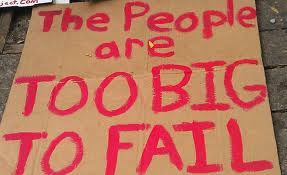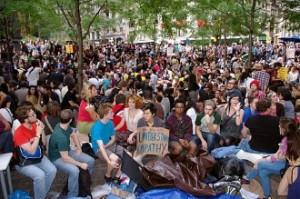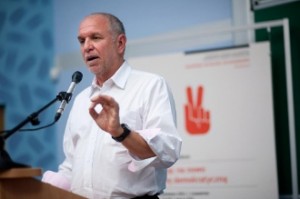A couple of weeks ago, I wrote a post about theOWS movement. Jeffrey Goldfarb, from the blog Deliberately Considered, provided insightful comments on this post which led to a productive e-mail exchange, and a plan to continue the conversation. Last week, I posted on Deliberately Considered, and Goldfarb responded. Below is my DC post and Goldfarb’s response.
Slacktivism Matters
Posted on Deliberately Considered by Jenny Davis, October 6th, 2011
Two recent posts on Deliberately Considered, one by Scott Beck and the other by Jeffrey C. Goldfarb, examine the role of social media in social movements. They demonstrate the way in which social media allow us to harness the power of the people, contest the interpretations of mainstream media, organize, and mobilize. They show how, through communications on digital networks, physical bodies have come together in physical spaces, protesting both ideological and material conditions.
The points made by Beck and Goldfarb are important ones, yet I believe they should be extended. In particular, we need to address not only the ways in which these new media technologies work to bring together and document the physical bodies who occupy physical spaces. We also must examin the role of those whose activism never goes beyond the digital realm. We must look at how this latter group, colloquially referred to as slacktivists, matter.
Slacktivism matters in two interrelated ways: 1) increasing visibility and 2) generating a particular zeitgeist surrounding social movements.
Not everyone reads and/or watches the news, and in the age of the 24 hour news media, those who do read and/or watch the news must necessarily be selective in what they consume. What we share on Facebook or tweet on Twitter, therefore, works to increase the visibility of particular news items. Moreover, by linking a news item to a familiar other, to someone inside an actor’s personal network, is to imbue the news item with relevance. Status updates and tweets about Occupy Wall Street, for example, not only spread information about the protests, but also locate the protests in the digitally networked space(s) of everyday life, designating them as part of a relevant conversation.
This sharing, of course, is rarely (if ever) done in a neutral manner. Rather, Tweeters and Facebookers accompany shared news stories and web links with commentary that reveals a particular bent, or interpretation of the content. The content is therefore not just made visible, but impregnated with meaning in a web of social relations. When shared and interpreted on a larger scale, this meaning-laden content generates a “feel” or “zeitgeist” surrounding an historical moment and the related social movement. This is clearly seen in the vast international support for both the Arab Spring (and now Arab Fall) and the Occupy Wall Street protests. We understand these as movements
links with commentary that reveals a particular bent, or interpretation of the content. The content is therefore not just made visible, but impregnated with meaning in a web of social relations. When shared and interpreted on a larger scale, this meaning-laden content generates a “feel” or “zeitgeist” surrounding an historical moment and the related social movement. This is clearly seen in the vast international support for both the Arab Spring (and now Arab Fall) and the Occupy Wall Street protests. We understand these as movements
by and for the people. We share a sense of anger towards oppression by the powerful few. We applaud those who strive to have their voices heard, and condemn those who wish to stifle the voices of the small and (individually)powerless.
Visibility and zeitgeist are not without material consequences. Theda Skocpol argues that social movements spread through visibility and modeling (see Sarah Wanenchak’s excellent discussion of this on Cyborgology). Just as the nations of the Arab world took cues from each other, the U.S. has now taken cues from the Arab world, resulting in feet onthe ground, posters in the air, and bodies occupying lower Manhattan, L.A., Boston, Austin and numerous other cities. By spreading the word, making it relevant, and generating a zeitgeist of freedom and rebellion, slacktivists not only show support for the recent international social movements, but actively augment them in symbolic and tangible ways.
In Review: OWS, the Occupation of Ground Zero
Posted on Deliberately Considered by Jeffrey C. Goldfarb on October 14th, 2011
I think that the form of Occupy Wall Street expresses its content, as Scott Beck showed in his earlier post on the occupation. I observed, further, that the way people use social media contributes to this form, as does the setting of the occupation. And I believe deliberating about the movement and connecting the debate to other political, social and cultural activities are keys to the democratic contribution of the movement to broader politics in America and beyond.
Jenny Davis in her post last week makes cogent points about the role of social media in social movements in general and in Occupy Wall Street in particular. Her key observation is very important. Digital activism is not only a means to the end of embodied social action. It also is an end in itself, a new type of politics that can make the previously hidden visible and can contribute to what shecalls “the zeitgeist,” what I would prefer calling the prevailing common sense.
I would add that it can constitute a space for free action, a public, a point made by Judith Butler in a recent lecture.http://www.eipcp.net/transversal/1011/butler/enThis is especially telling as David Peppas and Barbara note in the two comments to Davis’s post, because the occupation doesn’t have a simple meaning or political end. Its form is its content. The act of protest, as well as the act of posting, makes the world look differently, and looking at the world differently is what is most needed at this time, to face up to stark social realities that have been ignored and develop the capacity to act on this. It is interesting how the way this happens is structured by social media actions, no longer a monopoly of the mass media, while the power of the movement, is quite material. It’s embedded in a specific geography and its link to political culture.
The place of the occupation in an important way contributes to its power. Situated in lower Manhattan, the New York Stock Market and the World Trade Center have been symbols of advanced capitalism and American economic power in the global order and have been actual centers of the order. And, thus, to my mind, Occupy Wall Street is the ground zero social movement.
Ironically, mine is first of all a “pedestrian observation,” based on very particular experience. In recent weeks, I walked around the area on the tenth anniversary of the attack with my friend, Steve Assael, who survived the 9/11 attack, , including a stroll on Wall Street. And last week, I walked and observed the very same area when I went to take a look and to support the occupation at Zuccotti Park, passing by the site of the so called Ground Zero Mosque as well.
Because it is at the symbolic center, the media are paying attention to OWS. A relatively small social demonstration is capturing global attention, exciting political imagination. In the U.S., apparently the Tea Party has met its match.
A report yesterday indicates that Occupy Wall Street is more popular than the Tea Party. http://swampland.time.com/2011/10/13/why-occupy-wall-street-s-more-popular-than-the-tea-party/ Occupations of public spaces are spreading around the country, and, as the old slogan goes: the whole world is watching. Occupations are going global, eminating from ground zero to London,, Seoul, back to Los Angeles andWashington D.C. and many points in between.
They have been watching in Gdansk. I was surprised by the interest in the Occupy Wall Street demonstration when I lectured there, and surprised and pleased to read that an important figure from that city, indeed the city’s most important historic figure, Lech Walesa, the leader of the Solidarity Trade Union, is planning on coming to NY to support the occupation.http://www.nydailynews.com/ny_local/occupy_wall_street/2011/10/12/2011-10-12_lech_walesa_former_polish_president_to_visit_new_york_in_support_of_occupy_wall_.html
As reported in an unlikely source, The New York Daily News:
“Walesa has warned of a “worldwide revolt against capitalism” if the Wall St. protests are ignored. They are protesting the “unfairness” of an economy that enriches a few and “throws the people to the curb,” he said in a recent interview. “That’s why union leaders and capitalists need to figure out what to do, because otherwise they will have to contend with a worldwide revolt against capitalism.”
The news is spreading through mainstream media and publications. But I think it is also important how social media are spreading the word. Idon’t read the Daily News. It’s the American classic tabloid, similar to Murdoch’s NY Post, though not as bad. I got wind of the report through a friend’s (Elzbieta Matynia’s) Facebook page. The world is watching the world as mediated by our friends and our interpretation of things. As Davis observes:
“This sharing, of course, is rarely (if ever) done in a neutral manner. Rather, Tweeters and Facebookers accompany shared news stories and web links with commentary that reveals a particular bent, or interpretation of the content. The content is therefore not just made visible, but impregnated with meaning in a web of social relations.”
The Ground Zero occupation is leading to a global response. An articulate critique of the global order of things is being expressed in simple bodily presence and demonstrating expressions, capturing the attention of the world that is watching and acting upon what it sees, with the potential of changing the terms of public deliberations. Those who are concerned about jobs, inequality, global warming and much more have found their voices and are making visible their very real concerns. Indeed, I believe, in the U.S., the Tea Party has met its match. Both OWS and the Tea Party reveal the power of the politics of small things. In this sense, they are quite similar, but there is a major difference. OWS is
grounded in the reality based community, while much of the Tea Party concerns are based on fictoids, as we have been observing here at Deliberately Considered over the last year. As an unreconstructed enlightenment partisan, I think this suggests the long term power of the newest development on the global stage. As I observed in concluding my comparison between OWS and a social movement in South Korea, the candle light movement, a candle is, indeed, being lit. http://www.deliberatelyconsidered.com/201
1/10/a-specter-is-haunting-the-powers-that-be-thinking-about-korea-while-looking-at-wall-street/



Comments 3
cyborgology + #ows | Full-Stop.net — October 25, 2011
[...] blogger Jenny Davis wrote recently that people whose activism never leaves the digital realm shouldn’t be so readily dismissed as [...]
HRC Profile Pictures: In Defense of the Red Sea » Cyborgology — April 2, 2013
[...] new technologies and brings us back to the question: Does slacktivism matter? I will argue here, as I have argued before that yes, it [...]
Augmented Mobilization at the People’s Climate March - Treat Them Better — March 9, 2015
[…] of significant clustering in our variable supports previous work on online activist organizing, slacktivism, and digital tactics, all of which suggests that digitality can enhance mobilization and offer […]